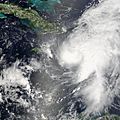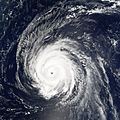Timeline of the 2006 Atlantic hurricane season facts for kids
This is a timeline of the 2006 Atlantic hurricane season. It shows when storms formed, got stronger or weaker, hit land, changed into other types of storms, or disappeared. The 2006 Atlantic hurricane season had an El Niño event. This usually means fewer storms, especially later in the year. The season officially started on June 1, 2006, and ended on November 30. When a storm hit land, it's written in bold text. This timeline also includes information that was found after the season by experts at the National Hurricane Center. Tropical Storm Zeta from 2005 lasted into 2006. That's why this timeline starts in January.
Contents
Timeline of Storms
January
- January 1
- 0000 UTC - The year 2006 begins with Tropical Storm Zeta still active. It carried over from the previous season. This made Zeta only the second storm ever to cross from one Atlantic hurricane season into the next.
- January 6
- 2 a.m. AST (0600 UTC) - Tropical Storm Zeta became weaker. It was now a tropical depression.
- 5 p.m. AST (2100 UTC) - The National Hurricane Center gave its last update on Tropical Depression Zeta. This finally ended the 2005 season.
June
- June 1
- The 2006 Atlantic hurricane season officially began.
- June 10
- 1 a.m. CDT (0600 UTC) - Tropical Depression One formed. It was about 120 nautical miles (220 km) south of western Cuba.
- 7 p.m. CDT (0000 UTC June 11) - Tropical Depression One got stronger. It became Tropical Storm Alberto.
- June 13
- 12:30 p.m. EDT (1630 UTC) - Tropical Storm Alberto made landfall near Adams Beach, Florida. Its winds were 45 mph (72 km/h).
- June 14
- 2 a.m. EDT (0600 UTC) - Tropical Storm Alberto became weaker. It was now a tropical depression.
- 8 a.m. EDT (1200 UTC) - The remains of Alberto changed into an extratropical storm.
- 5 p.m. EDT (2100 UTC) - The HPC gave its first and only update on the remains of Tropical Depression Alberto.
July
- July 17
- 0600 UTC - A low pressure area that was extratropical became a tropical depression. This happened about 210 nautical miles (390 km) southeast of Nantucket, Massachusetts. However, this depression was not given a number or warned about by the National Hurricane Center at the time.
- 1200 UTC - The tropical depression near Nantucket got stronger. It became a tropical storm, but it was not given a name at the time.
- July 18
- 8 a.m. EDT (1200 UTC) - Tropical Depression Two formed. It was about 250 nautical miles (645 km) east-southeast of Wilmington, North Carolina.
- 1200 UTC - The unnamed tropical storm weakened into a leftover low pressure area.
- 2 p.m. EDT (1800 UTC) - Tropical Depression Two got stronger. It became Tropical Storm Beryl.
- July 21
- 2:45 a.m. EDT (0645 UTC) - Tropical Storm Beryl made landfall on Nantucket island, Massachusetts. Its winds were 50 mph (80 km/h).
- 2 p.m. EDT (1800 UTC) - Tropical Storm Beryl changed into an extratropical storm.
- July 31
- 8 p.m. EDT (0000 UTC August 1) - Tropical Depression Three formed. It was about 205 nautical miles (380 km) east-southeast of Barbuda.
August
- August 1
- 2 a.m. AST (0600 UTC) - Tropical Depression Three got stronger. It became Tropical Storm Chris.
- August 3
- 2 p.m. AST (1800 UTC) - Tropical Storm Chris became weaker. It was now a tropical depression.
- August 4
- 2 a.m. AST (0600 UTC) - Tropical Depression Chris weakened into a low pressure area.
- August 21
- 2 p.m. AST (1800 UTC) - Tropical Depression Four formed. It was about 225 nautical miles (415 km) south-southeast of Praia, Cape Verde.
- August 22
- 8 p.m. AST (0000 UTC August 23) - Tropical Depression Four got stronger. It became Tropical Storm Debby.
- August 24
- 2 p.m. AST (1800 UTC) - Tropical Depression Five formed in the Caribbean Sea. It was about 40 nautical miles (75 km) north-northwest of Grenada.
- August 25
- 8 a.m. AST (1200 UTC) - Tropical Depression Five got stronger. It became Tropical Storm Ernesto.
- August 26
- 2 a.m. AST (0600 UTC) - Tropical Storm Debby became weaker. It was now a tropical depression.
- 8 a.m. AST (1200 UTC) - Tropical Depression Debby weakened into a low pressure area.
- August 27
- 2 a.m EDT (0600 UTC) - Tropical Storm Ernesto got stronger. It became Hurricane Ernesto.
- 8 a.m. EDT (1200 UTC) - Hurricane Ernesto became weaker. It was now a tropical storm.
- August 28
- 7:15 a.m. EDT (1115 UTC) - Tropical Storm Ernesto made its first landfall in Cuba at Playa Cazonal. Its winds were 40 mph (64 km/h).
- August 29
- 11 p.m. EDT (0300 UTC) - Tropical Storm Ernesto made a second landfall at Plantation Key, Florida. Its winds were 45 mph (72 km/h).
- August 30
- 1 a.m. EDT (0500 UTC) - Tropical Storm Ernesto made a third landfall in southwestern Miami-Dade County. Its winds were 45 mph (72 km/h).
- August 31
- 11:40 p.m. EDT (0340 UTC September 1) - Tropical Storm Ernesto made a fourth landfall at Oak Island, North Carolina. Its winds were 70 mph (113 km/h).
September
- September 1
- 8 a.m. EDT (1200 UTC) - Tropical Storm Ernesto became weaker. It was now a tropical depression.
- 2 p.m. EDT (1800 UTC) - Tropical Depression Ernesto changed into an extratropical storm with strong winds.
- September 2
- 11 p.m. EDT (0300 UTC September 3) - The HPC gave its final update on the extratropical remains of Ernesto.
- September 3
- 2 p.m. AST (1800 UTC) - Tropical Depression Six formed. It was about 855 nautical miles (1585 km) west of the Cape Verde Islands.
- September 5
- 2 a.m. AST (0600 UTC) - Tropical Depression Six got stronger. It became Tropical Storm Florence.
- September 10
- 2 a.m. AST (0600 UTC) - Tropical Storm Florence got stronger. It became Hurricane Florence.
- 2 p.m. EDT (1800 UTC) - Tropical Depression Seven formed. It was about 470 nautical miles (870 km) east-northeast of the Leeward Islands.
- September 11
- 8 a.m. EDT (1200 UTC) - Tropical Depression Seven got stronger. It became Tropical Storm Gordon.
- September 12
- 8 a.m. EDT (1200 UTC) - Tropical Depression Eight formed. It was about 200 nautical miles (370 km) south-southeast of the Cape Verde Islands.
- 8 p.m. AST (0000 UTC September 13) - Hurricane Florence changed into an extratropical storm.
- 8 p.m. EDT (0000 UTC September 13) - Tropical Storm Gordon got stronger. It became Hurricane Gordon.
- September 13
- 2 p.m. EDT (1800 UTC) - Hurricane Gordon reached Category 2 strength.
- 8 p.m. AST (0000 UTC September 14) - Hurricane Gordon reached Category 3 strength. This made it the first major hurricane of the season.
- 8 p.m. AST (0000 UTC September 14) - Tropical Depression Eight got stronger. It became Tropical Storm Helene.
- September 16
- 8 a.m. AST (1200 UTC) - Tropical Storm Helene got stronger. It became Hurricane Helene.
- September 17
- 2 p.m. AST (1800 UTC) - Hurricane Helene reached Category 2 strength.
- 8 p.m. AST (0000 UTC September 18) - Hurricane Helene reached Category 3 strength. This made it the second major hurricane of the season.
- September 19
- 11 p.m. AST (0300 UTC September 20) - Hurricane Gordon passed near the Central Azores. Its eye stayed offshore.
- September 20
- 8 p.m. AST (0000 UTC September 21) - Hurricane Gordon changed into an extratropical storm.
- September 24
- 2 p.m. AST (1800 UTC) - Hurricane Helene changed into an extratropical storm.
- September 27
- 2 p.m. EDT (1800 UTC) - Tropical Depression Nine formed. It was about 810 nautical miles (1500 km) east-southeast of Bermuda.
- September 28
- 2 a.m. EDT (0600 UTC) - Tropical Depression Nine got stronger. It became Tropical Storm Isaac.
- September 30
- 8 a.m. AST (1200 UTC) - Tropical Storm Isaac got stronger. It became Hurricane Isaac.
October
- October 2
- 8 a.m. AST (1200 UTC) - Hurricane Isaac became weaker. It was now a tropical storm.
- 8 p.m. AST (0000 UTC October 3) - Tropical Storm Isaac changed into an extratropical storm.
November
- There were no tropical storms or hurricanes in the Atlantic in November.
- November 30 was the official end of the 2006 Atlantic hurricane season.
Related Pages
Images for kids

All content from Kiddle encyclopedia articles (including the article images and facts) can be freely used under Attribution-ShareAlike license, unless stated otherwise. Cite this article:
Timeline of the 2006 Atlantic hurricane season Facts for Kids. Kiddle Encyclopedia.





